Box #2: Language Policy & Literacy
Description of artifacts
Qu'ranic Writing Boards and Bamboo Stick 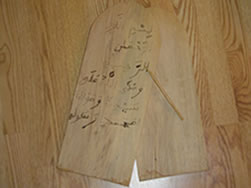
What does it mean to be literate? In Senegal , some very young children are first exposed to writing by learning to read and write religious text on Qu'ranic Writing Boards. These boards are used to learn the Arabic alphabet, verse of the Qu'ran, and the intellectual traditions that go along with the spread of Islam across the continent. The writing on the first board is the Blessing of God , which reads, " In the name of God, merciful and most compassionate, the blessing of God our Lord and master Muhammad his profit"
Bamboo sticks are carved into writing implements, and the Qu'ranic writing boards are used as the canvas for early literacy.
Plastic Writing Slates
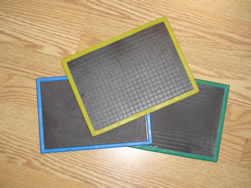
The women enrolled in the national literacy projects use plastic writing slates. When the facilitator asked the women to write a letter, syllable, or sentence, they used the slates as their canvass. Each woman would hold up her slate to be viewed by the facilitator, at the front of the class.
Poster of child holding and using a Qu'ranic Writing Board
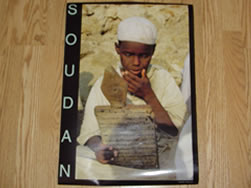
This poster is a museum reproduction from another part of the African continent where they have large sectors of the Islamic population. Pictured is a child from Sudan in East Africa using a Qu'ranic Writing Board.
Poster of the Arabic Alphabet
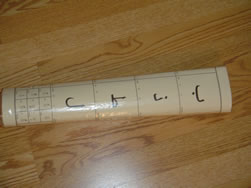
This poster can be used to illustrate the Arabic Alphabet.
Children's Books (5)
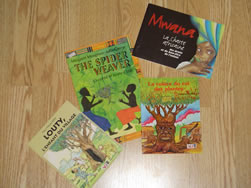 This box contains five children's books, which can be used in various ways.
This box contains five children's books, which can be used in various ways.
- Our notions of emergent literacy are challenged when thinking of teaching children book awareness, e.g., where is the front of the book, where is the back of the book, etc. One book, which opens from left to right, contains labels of common objects in Arabic, French, and English.
- Another book, Louty L'enfant du village , might be used to illustrate how some homes are constructed in the villages.
- The pictures in the book, La Colere du roi des plantes (The anger of the king of the plants) can be used to tell a story, and to illustrate the similarities and differences in the way stories might be structured and illustrated in Senegal and France vs. the U. S.
- The Rights of Children is a book about the human rights issues in Senegal .
- The Spider Weaver is a popular book in the U. S. , but was purchased in Senegal . It tells the story of the Kente Cloth.
Wolof Grammar Language Book and Wolof Dictionary
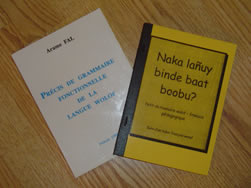
These texts will be useful for those who are speakers of French, wishing to learn a few words in Wolof. Wolof is one of the six national languages in Senegal . Those interested in the structure of languages can also use the grammar book, where one can make comparisons of grammar across languages. A French/Wolof dictionary is also included. For further information on Wolof you can consult the following sources:
- African Students Association at Western Michigan University
- Michigan State University International Studies Department
Few other items in the inventory box 2:
Videos (2)
There are two videos in the Language Policy and Literacy Artifact Box.- The first is called Picc Mi by Mansour Sara Wade. This movie is about a talibé, a child entrusted to a marabout (i.e., a religious leader) to learn Islam. It shows images of the talibé in a daara (Qu'ranic School) using the Qu'ranic writing boards. [ Rating unknown - the teacher should pre-view the movie before showing it in class ]
- The second video is called Guelewaar by Ousmane Sembene, one of the most famous movie writers and producers in Senegal . This video is presented in French and Wolof, one of the six national languages in Senegal . It is a comedy that critiques foreign aid and pride. If used with younger children, this video could be used to show how the different languages sound differently from each other and from English. [ Rating unknown - the teacher should pre-view the movie before showing it in class ]
Post Cards (9)
Nine post cards are included in the box that can illustrate some aspects of Senegalese life.
Photographs with Commentary (17)
A set of photographs is provided. On the reverse side of the laminated pictures is a description of the picture and the context in which the events portrayed in the picture took place.
Course Syllabus and Accompanying Case Studies
The course plan was designed for an upper level graduate course university course about communication, language and culture. The teaching units can be adapted to elementary, middle school, high school, and undergraduate levels as well.